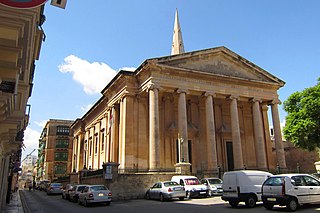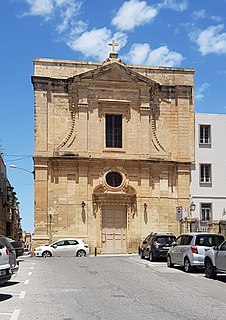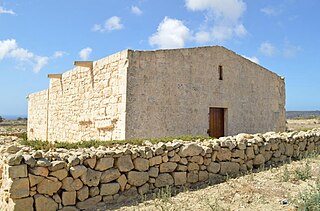
Valletta is the capital city of Malta. Located in the South Eastern Region of the main island, between Marsamxett Harbour to the west and the Grand Harbour to the east, its population in 2014 was 6,444, while the metropolitan area around it has a population of 393,938. Valletta is second only to Nicosia as the southernmost capital of Europe, and at just 0.61 square kilometres (0.24 sq mi), it is the European Union's smallest capital city.

António Manoel de Vilhena was a Portuguese nobleman who was the 66th Prince and Grand Master of the Order of St. John of Jerusalem from 19 June 1722 to his death in 1736. Unlike a number of the other Grand Masters, he was benevolent and popular with the Maltese people. Vilhena is mostly remembered for the founding of Floriana, the construction of Fort Manoel and the Manoel Theatre, and the renovation of the city of Mdina.

Fort Manoel is a star fort on Manoel Island in Gżira, Malta. It was built in the 18th century by the Order of Saint John, during the reign of Grand Master António Manoel de Vilhena, after whom it is named. Fort Manoel is located to the north west of Valletta, and commands Marsamxett Harbour and the anchorage of Sliema Creek. The fort is an example of Baroque architecture, and it was designed with both functionality and aesthetics in mind.

Fort Saint Elmo is a star fort in Valletta, Malta. It stands on the seaward shore of the Sciberras Peninsula that divides Marsamxett Harbour from Grand Harbour, and commands the entrances to both harbours along with Fort Tigné and Fort Ricasoli. It is best known for its role in the Great Siege of Malta of 1565.

Fort St. Angelo is a bastioned fort in Birgu, Malta, located at the centre of the Grand Harbour. It was originally built in the medieval period as a castle called the Castrum Maris. It was rebuilt by the Order of Saint John as a bastioned fort called Fort Saint Angelo between the 1530s and the 1560s, and it is best known for its role as the Order's headquarters during the Great Siege of Malta of 1565. A major reconstruction to designs of Carlos de Grunenbergh took place in the 1690s, giving the fort its current appearance.

Saint James Cavalier is a 16th-century cavalier in Valletta, Malta, which was built by the Order of St John. It overlooks St James' Bastion, a large obtuse-angled bastion forming part of the Valletta Land Front. St James was one of nine planned cavaliers in the city, although eventually only two were built, the other one being the identical Saint John's Cavalier. It was designed by the Italian military engineer Francesco Laparelli, while its construction was overseen by his Maltese assistant Girolamo Cassar. St James Cavalier never saw use in any military conflict, but it played a role during the Rising of the Priests in 1775.

The Valletta Waterfront, is a promenade in Valletta, Malta, mainly featuring three prominent buildings: a church in the middle, the Pinto Stores or the Pinto Wharf on the left, and the Forni Stores or the Forni Shopping Complex on the right. The buildings were originally stores and warehouses, built in the 18th century, and the design is attributed to Andrea Belli.

St Paul's Pro-Cathedral, officially The Pro-Cathedral and Collegiate Church of Saint Paul, is an Anglican pro-cathedral of the Diocese in Europe situated in Independence Square, Valletta, Malta. A "pro-cathedral" is a church with cathedral status though not being the main cathedral. It is one of three cathedrals of the Anglican Diocese of Gibraltar in Europe.

The Cittadella, also known as the Castello, is the citadel of Victoria on the island of Gozo, Malta. The area has been inhabited since the Bronze Age, and the site now occupied by the Cittadella is believed to have been the acropolis of the Punic-Roman city of Gaulos or Glauconis Civitas.

The Church of the Circumcision of Our Lord, commonly known as the Jesuits' church, is one of the oldest churches in Valletta, Malta, and one of the largest in the diocese. It was originally built between 1593 and 1609 by the Jesuit order, and it is located adjacent to the Old University Building, which originally housed a Jesuit college known as the Collegium Melitense. The church was rebuilt in the Baroque style by Francesco Buonamici after suffering extensive damage in an explosion in 1634. The church remained in use after the Jesuits were expelled from Malta in 1768, and it is also used for Masters and Doctoral graduation ceremonies of the University of Malta, the successor to the Collegium Melitense.

The Church of St Mary Magdalene is a Roman Catholic church building in Valletta, Malta. The church, named after Jesus' companion Mary Magdalene, was part of the Magdalene asylum situated adjacent to the church. The church was deconsecrated in the mid 20th century and was blessed again by Bishop Charles Scicluna on 25 February 2015.

The fortifications of Malta consist of a number of walled cities, citadels, forts, towers, batteries, redoubts, entrenchments and pillboxes. The fortifications were built over thousands of years, from around 1450 BC to the mid-20th century, and they are a result of the Maltese islands' strategic position and natural harbours, which have made them very desirable for various powers.

The fortifications of Valletta are a series of defensive walls and other fortifications which surround Valletta, the capital city of Malta. The first fortification to be built was Fort Saint Elmo in 1552, but the fortifications of the city proper began to be built in 1566 when it was founded by Grand Master Jean de Valette. Modifications were made throughout the following centuries, with the last major addition being Fort Lascaris which was completed in 1856. Most of the fortifications remain largely intact today.

The fortifications of Senglea are a series of defensive walls and other fortifications which surround the city of Senglea, Malta. The first fortification to be built was Fort Saint Michael in 1552, and the majority of the fortifications were built over the next decade when it was founded by Grand Master Claude de la Sengle. Modifications continued until the 18th century, but large parts of the fortifications were demolished between the 19th and 20th centuries. Today, all that remain of Senglea's fortifications are the seaward bastions and part of the land front.

The Church of Our Lady of Liesse is a church in Valletta, Malta. The church was built in 1740 on the site of a 17th-century church. The cupola was built to the designs of the Maltese Architect Francesco Zammit. The church is located near the shores of the Grand Harbour, close to Lascaris Battery and the site of the fish market. It is especially venerated by the people of the port area.

The St Cecilia Chapel is a former Roman Catholic chapel in the limits of Xewkija, Gozo, Malta, dedicated to Saint Cecilia. It was built in around 1540, but it was deconsecrated in 1644, being converted into an ancillary building for the nearby Santa Cecilia Tower.

The Great Siege Monument, also known as the Monument to the Fallen of the Great Siege, is a monument commemorating the Great Siege of Malta located in Valletta, Malta. It consists of three bronze figures symbolizing Faith, Fortitude, and Civilization, standing on top of a granite base. The monument is the work of the sculptor Antonio Sciortino, and it was inaugurated on 8 May 1927.

The Chapel of St Anne is a Roman Catholic chapel located in Fort Saint Elmo in Valletta, Malta. Its existence was first documented in the late 15th century, and it was incorporated into the fort when the latter was constructed by the Order of St John in the mid-16th century. The chapel's present state dates back to the mid-17th century.

The Chapel of St Anthony of Padua is a Roman Catholic chapel located in Fort Manoel on Manoel Island in Gżira, Malta. It was completed in 1727 as an integral part of the fort, and it was partially destroyed by aerial bombardment in 1942 during World War II. The chapel was reconstructed as part of a restoration project and it was completed in 2009.

The Chapel of St Anne is a Roman Catholic chapel in Fort St Angelo in Birgu, Malta. Its existence was first documented in the 13th century, and according to tradition it stands on the site of an ancient temple. The present building was constructed in around 1430 and it was enlarged in 1532 by the Order of St John. The building ceased to function as a chapel in 1798, and it was used as a store, as a school and as a Church of England chapel before being converted back to a Catholic chapel in the mid-20th century. It has been restored and it is now managed by the Sovereign Military Order of Malta.























